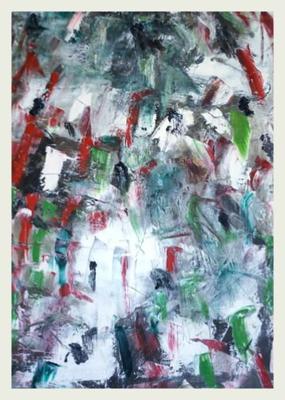Art Does Have an Impact: Visitors Respond
Sharing Memories, Hopes and Fears at Artists Respond: American Art and the Vietnam War, 1965-1975
Melissa Hendrickson is an Interpretation and Audience Research Specialist at SAAM.
More than forty years after its conclusion, the Vietnam War remains an emotional and affecting topic. Whether you lived through the conflict or were born long after its end, you likely have strong feelings about this divisive period in American history. Artists Respond: American Art and the Vietnam War, 1965-1975, on view through August 18, 2019 at the Smithsonian American Art Museum, explores the era through the lens of its artwork.
During the war, artists, like many ordinary Americans, felt compelled to respond to their political, social, and cultural moment. The artworks they created are powerful and provocative, reflecting the turmoil and passion of the decade. Recognizing the strong emotions inherent to the topic and works, SAAM’s interpretation team worked closely with curator Melissa Ho to create space in the exhibition for visitors to rest, reflect, and respond.
Our process began by engaging with SAAM visitors. Through surveys, interviews, and in-depth focus groups, we explored visitors’ associations with the Vietnam War, their questions about the exhibition’s content, and how the museum could best support their experience.
One result of that feedback was the creation of a dedicated interpretive gallery. This discrete space includes an in-depth timeline, which puts exhibition artworks into context with major political and social events of the period, as well as a communal table, where visitors are invited to pause, reflect, and connect with friends or strangers.
A major element of the interpretive gallery is an extensive response wall, which encourages visitors to share written feedback through two prompts: “The art in this exhibition makes me think…” and “The art in this exhibition makes me feel…”
To date, nearly four thousand people have shared their reactions. Their responses reflect a range of emotions: pride, shame, regret, awe, confusion, optimism, fear. Some share their memories of the Vietnam War era and their own experience as a soldier or activist. Others express frustration at their lack of knowledge about the period and their desire to learn more about its overlooked histories. Some recognize soldiers of color, who were drafted in disproportionately high numbers. Others honor family members who came to the United States as refugees from Southeast Asia. Many draw parallels to the contemporary moment and reflect on lessons learned, or ignored.
The handful of cards below represent a range of distinct voices, thoughts, and personal responses. If you’d like to visit and add your thoughts to the interpretive gallery, the exhibition remains on view through August 18, 2019. Following the presentation at SAAM, the exhibition will travel to the Minneapolis Institute of Art where it will be on display from Sept. 29 through Jan. 5, 2020.
Translation: We will need a few more generations to ease the pain of the Vietnam War












